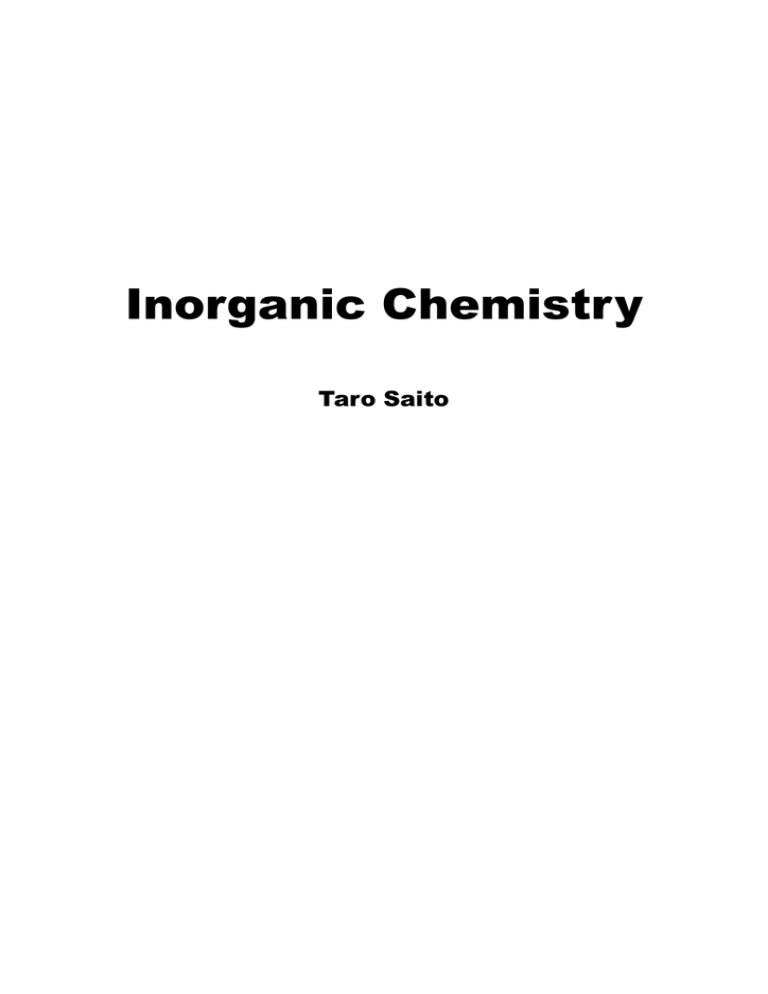Inorganic Chemistry Taro Saito
advertisement

Inorganic Chemistry Taro Saito Preface The author has tried to describe minimum chemical facts and concepts that are necessary to understand modern inorganic chemistry. All the elements except superheavy ones have been discovered and theoretical frameworks for the bonding, structure and reaction constructed. The main purposes of inorganic chemistry in near future will be the syntheses of the compounds with unexpected bonding modes and structures, and discoveries of novel reactions and physical properties of new compounds. More than ten million organic compounds are known at present and infinite number of inorganic compounds are likely to be synthesized by the combination of all the elements. Recently, really epoch making compounds such as complex copper oxides with high-temperature superconductivity and a new carbon allotrope C60 have been discovered and it is widely recognized that very active research efforts are being devoted to the study of these compounds. By the discoveries of new compounds, new empirical laws are proposed and new theories are established to explain the bondings, structures, reactions, and physical properties. However, classical chemical knowledge is essential before studying new chemistry. Learning synthetic methods, structures, bondings, and main reactions of basic compounds is a process requisite to students. This text book describes important compounds systematically along the periodic table, and readers are expected to learn typical ones both in the molecular and solid states. The necessary theories to explain these properties of compounds come from physical chemistry and basic concepts for learning inorganic chemistry are presented in the first three chapters. Inorganic chemistry is of fundamental importance not only as a basic science but also as one of the most useful sources for modern technologies. Elementary substances and solid-state inorganic compounds are widely used in the core of information, communication, automotive, aviation and space industries as well as in traditional ones. Inorganic compounds are also indispensable in the frontier chemistry of organic synthesis using metal complexes, homogeneous catalysis, bioinorganic functions, etc. One of the reasons for the rapid progress of inorganic chemistry is the development of the structural determination of compounds by X-ray and other analytical instruments. It has now become possible to account for the structure-function relationships to a considerable extent by the accumulation of structural data on inorganic compounds. It is no exaggeration to say that a revolution of inorganic chemistry is occurring. We look forward to the further development of inorganic chemistry in near future. The present text is a translation from a Japanese text book in the series of i introductory courses for the freshman, and junior students. The series has been welcome widely in Japan since their first publication in 1996 as unique approaches to modern chemistries that are becoming too complex to learn during the short period of university courses. This internet version is intended to offer free textbooks for those students who have little access to the printed version and we hope that readers will benefit from this experimental edition. The author expresses his acknowledgments to Professor Yoshito Takeuchi for his efforts to realize the project and Iwanami Publishing Company to approve the publication of the internet edition without claiming a copyright for translation. May 10, 2004 Kanagawa University Taro Saito ii Contents 1 Elements and periodicity 1.1 The origin of elements and their distribution 1.2 Discovery of elements 1.3 Electronic structure of elements 1.4 Block classification of the periodic table and elements 1.5 Bonding states of elements 1 2 2 6 7 2 Bonding and structure 2.1 Classification of bonding 2.2 Geometrical factors governing bonding and structure 2.3 Electronic factors which govern bonding and structure 11 12 27 3 Reaction 3.1 Thermodynamics 3.2 Electrochemistry 3.3 Oxidation and reduction 3.4 Acid and base 4 Chemistry of nonmetallic elements 4.1 Hydrogen and hydrides 4.2 Main group elements of 2nd and 3rd periods and their compounds 4.3 Oxygen and oxides 4.4 Chalcogen and chalcogenides 4.5 Halogens and halides 4.6 Rare gases and their compounds 5 Chemistry of main-group metals 5.1 Group 1 metals 5.2 Group 2 metals 5.3 Group 12 metals 5.4 Group 13 metals 5.5 Group 14 metals 41 42 45 48 54 58 66 86 89 98 101 103 105 105 108 iii 6 Chemistry of transition metals 6.1 Structures of metal complexes 6.2 Electronic structure of complexes 6.3 Organometallic chemistry of d block metals 6.4 Reactions of complexes 110 116 130 148 7 Lanthanoids and actinoids 7.1 Lanthanoids 7.2 Actinoids 154 155 8 Reaction and physical properties 8.1 Catalytic reactions 8.2 Bioinorganic chemistry 8.3 Physical properties 159 163 166 iv




